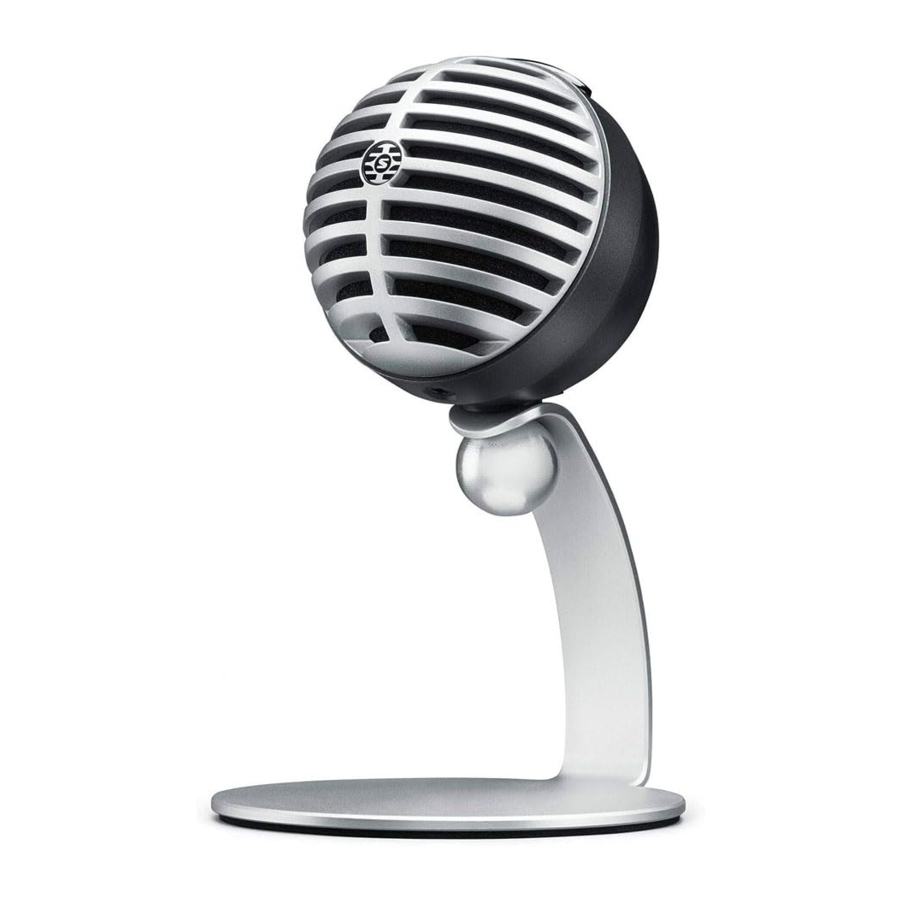
Shure MV5 - Digital Condenser Microphone Manual
- User manual (70 pages) ,
- Manual (6 pages) ,
- User manual (30 pages)
Advertisement

General Description
The Shure MV5 microphone connects directly to a computer or mobile device over a USB or Lightning® connection. Ideal for home recording or podcasting, the MV5 features preset voice and instrument record modes for fast, easy configuration.
Features
- Convenient, Compact Design: This sleek and durable microphone mounts on the MV5 desktop stand or any stand with a 1/4" threaded adapter.
- Plug and Play: The MV5 automatically becomes the active audio device when plugged into a USB or Lightning compatible device.
- Preset Modes: Minimize setup time with preset DSP modes designed to adjust your gain, equalization and compression for a variety of applications.
Quick Setup
- Connect the microphone to a computer or mobile device. Use the appropriate cable (USB or Lightning).
The Green status LED indicates a successful connection.
Note: When using apps like Voice Memo, the LED will not light until Record is engaged. - Confirm that the MV5 is the selected audio device.
Most computers and mobile devices automatically detect the MV5 and assign it as the primary audio device. If your computer settings default to another device, open the sound control panel and select the MV5. To quickly verify that the device is recognized, plug headphones into the MV5 audio output and play an audio track. If you can hear sound, the microphone is functioning properly.
Note: When the MV5 is assigned as the audio device, all monitoring and playback from the recording software goes to the headphone output of the MV5. - Use the MODE button to select the preset mode that fits your application.
If the audio is too quiet or causes distortion, gain can be manually configured. However, the modes typically do not require additional gain adjustments. Refer to the "Adjusting Microphone Level" topic in this guide for details. - In your recording application, select the MV5 as the input source.
See your software user guide for information on assigning input sources. - Record.
The microphone is ready to use!
Connections and Controls
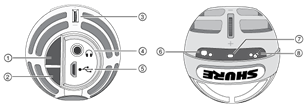
- Mode Selection Button
Press to switch between preset modes - Mute Button
Press to mute the microphone input - Headphone Volume Control
Adjusts the headphone volume - Headphone Output
Plug in any headphones with a 3.5 mm (1/8 inch) connector - Micro USB Port
Use the appropriate cable (USB or Lightning) to connect the MV5 to a computer or mobile device - Voice Mode
The LED indicator illuminates when this mode is selected - Status Indicator
LED Behavior Status Green Active USB or Lightning connection Flashing Red (all 3 LEDs) Muted - Instrument Mode
The LED indicator illuminates when this mode is selected
Note: Flat Mode is engaged when both mode LEDs are off.
Preset Modes
Three selectable modes adjust settings for gain, equalization, and dynamics to bring out the best sound characteristics for your recording needs.
| Mode | Application | Characteristics |
 | Use for speech or vocals in podcasting or musical applications | Equalization to emphasize clarity and fullness, and gentle compression to keep levels consistent. A de-esser reduces sibilance (the harsh sound that occurs when words with an "S" are spoken). |
 | Best for acoustic instru ments and live music ap plications | Transparent compression to smooth out volume spikes and bring quiet passages forward. Equalization emphasizes detail and gives an overall natural sound. |
 | Suited for any application | A completely unprocessed signal (no equalization or compression settings used). Adds flexibility when processing the audio after recording. |
Advanced Mic Settings
After you have selected the preset mode for your application, fine tune the sound of your recording with limiter, compressor, and equalizer controls. Your settings will be retained in the microphone when using other audio and video recording applications.
Limiter
Toggle the limiter on to set an input threshold and prevent distortion from volume peaks in your recordings.
Compressor
Choose no compression, or select light or heavy compression to control volume when your sound source is dynamic. The compressor will narrow the dynamic range, which means that quiet signals are boosted and loud signals are lowered.
Equalizer
![]() Change the preset modes to hear the DSP changes, and then use the equalizer to boost or cut bands of frequencies to improve sound clarity.
Change the preset modes to hear the DSP changes, and then use the equalizer to boost or cut bands of frequencies to improve sound clarity.
Note: Equalization within presets will not be displayed. However, the equalizer graphic in the advanced settings status bar displays the user selected equalization.

Tap to access the MOTIV equalizer. Equalization changes are displayed in the equalizer image.
EQ persists between preset mode changes.
Placement
This section suggests microphone placement for typical use cases. Keep in mind that there are many effective ways to record a given source. Experiment with microphone placement and settings to find what works best.
Podcast and Voice Recording
Set the microphone to the Voice mode. Speak directly into the front of the microphone, 2-12 inches (5-30 cm) away. Speaking closer to the microphone results in more bass response, similar to voices on a radio broadcast. Make additional gain adjustments if necessary.
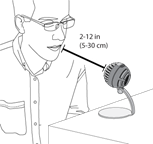
Music, Singing, and Acoustic Instruments
To capture acoustic sources, such as singing, acoustic guitar, soft percussion, or other musical instruments, use a close microphone placement. Start with Instrument mode for best results.
Aim the microphone directly at the sound source. For a single source, such as a string instrument or a vocalist, place the microphone 6 to 12 inches (15 to 30 cm) away. For a small group or a performer who is singing and playing an instrument simultaneously, use a distance of 2 to 10 feet (0.6m to 3 m). Placing the microphone farther away results in more ambient room sound. Make additional gain adjustments if necessary.
Bands and Louder Sources
To record a band with drums, amplified instruments, or any other loud sources, start with Instrument mode for best results. Aim the microphone towards the group at a distance of 6 to 15 feet (1.83 to 4.6 m). Placement of the microphone depends on the size of the room, number of people, and instrument volume. If possible, walk around the room and listen to find where it sounds best. Make additional gain adjustments if necessary.
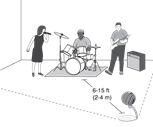
For a single electric guitar amplifier, aim the microphone towards the center of the speaker at a distance of 0 to 18 inches (0 to 45 cm).
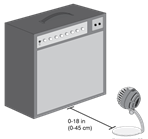
Additional Tips
Shure offers additional educational publications on recording techniques for specific instruments and applications. Visit www.shure.com for more information.
Adjusting Microphone Level
Microphone level (gain) typically does not need adjustment when using the appropriate preset mode. However, if you hear distortion or the audio is too low, adjust the microphone level in the Audio or Sound control panel of your computer or recording device.
Keep the following in mind:
- Set the microphone level before adjusting headphone volume.
- The headphone volume does not affect the signal level sent to the computer.
- Use the thumbwheel on the microphone to adjust headphone volume to a comfortable level. Do not change microphone gain to adjust the headphone volume.
Adjusting Headphone Level
The headphone monitoring level is affected by the device and the computer settings level. Raise your computer volume and easily adjust headphones through the MV5 thumbwheel.

Accessing the Control Panel
Windows
- Open the sound control panel and select the Recording tab.
- Open the Shure MV5 device.
- Under the Levels tab, adjust the gain level using the slider.
Mac®
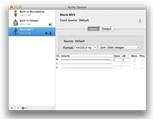
Mac audio settings panel
- Open the Audio Midi Settings panel.
- Select the Shure MV5 device.
- Click on Input to adjust the gain using the slider.
Input Meter Level
If your digital audio workstation or recording software has input meters, adjust the microphone level so it peaks between -12 and -6 dB. Otherwise, simply listen to the audio to make sure it is loud enough and not distorting.

Peak Levels
The target range for peak levels on a typical meter is between -12 and -6 dB.
Listening Through Headphones
The headphone jack provides an equal blend of the direct microphone signal and audio playback from the computer. This allows you to conveniently adjust the headphone volume for both with one control, the thumbwheel on the MV5. To adjust the amount of playback audio relative to the direct microphone signal, use the computer or DAW mixer settings.
Tip: When first connecting the microphone to your computer, make sure to raise the volume level in the sound control panel of the computer for a strong audio signal. Then adjust headphone level for comfortable monitoring.
Sampling Rate and Bit Depth
Sample Rate and Bit Depth settings are found in a drop down menu in the audio or sound control panel of your computer. You can adjust these variables to fit your needs. Select a lower sample rate for podcast recording, when it is important to have a smaller file for easy download. Select a higher sample rate for music and more dynamic recordings.
Tip: Record at a higher sample rate and bounce down to an M4A for a file with the highest sound quality at a manageable size.
Tip for PC users: Make sure that the sample rate and bit depth microphone settings, found in the sound control panel of the computer, match with the sample rate and bit depth selected in your software.
Troubleshooting
| Issue | Solution |
| The display does not illumi nate | Make sure that the MV5 is fully plugged in. |
| Audio is too low | Check the computer sound control panel settings. When first connecting the MV5 to your computer, make sure to raise the computer volume level. |
| Audio sounds bad | Check the sound control panel of the computer to ensure that the MV5 is fully plugged in and recognized. |
| Audio is distorted | Use the audio meter to ensure that volume peaks are within the target range. If level is reaching the red peak indicator of the input meter, turn the gain down. |
| Audio sounds unnatural or jittery | Make sure that the sample rate and bit depth microphone settings, found in the sound control panel of the computer, are consistent with the sample rate and bit depth selected in your software. |
| MV5 is plugged in, but the volume meter does not regis ter a signal. | Edit the privacy setting for the iOS device under SETTINGS > PRIVACY > MICROPHONE to give the recording application permission to use the microphone. |
| Device not working with USB hub. | The MV5 requires 250 mA per port. Check USB hub documentation for current/port speci fication. |
System Requirements
System Requirements and Compatibility: Mac
- Minimum 2 GB of RAM
- Minimum 500 MB of hard disk space
- MacOS 10.13 to 10.1
- bit
System Requirements and Compatibility: Windows
- Minimum 2 GB of RAM
- Minimum 500 MB of hard disk space
- Windows 10
- 64 bit
System Requirements and Compatibility: iOS
- iOS: iOS 14 and higher
- iPhone: iPhone 6s and higher
- iPod Touch: 7th gen
- iPad: iPad 5th gen and higher
- iPad Mini: iPad Mini 4th gen and higher
System Requirements and Compatibility: Android
Will work with any Android device that has:
- Android Pie 9.0 and higher
- USB Host Power Requirement of ≥100 mA
- USB Audio Class 1.1 support and higher
Android is a trademark of Google Inc.
Note: See https://www.shure.com/MOTIVcompatibility for information on supportive Android devices.
Specifications
MFi Certified
Yes
DSP Modes (Presets)
Voice/Instrument/Flat
Cartridge Type
Electret Condenser (16 mm)
Polar Pattern
Unidirectional (Cardioid)
Bit Depth
16-bit/24-bit
Sampling Rate
44.1/48 kHz
Frequency Response
20 Hz to 20,000 Hz
Adjustable Gain Range
0 to +36 dB
Sensitivity
40 dBFS/Pa at 1 kHz[1] [2}
Maximum SPL
130 dB SPL [2]
Headphone Output
3.5 mm (1/8')
Power Requirements
Powered through USB or Lightning connector
Mute Switch Attenuation
Yes
Mounting Stand
Included
Stand Adapter
1/4 inch 20 thread (standard tri-pod mount)
Housing
PC/ABS
Net Weight
| Without Mounting Stand | 0.09 kg (3.17oz.) |
| With Mounting Stand | 0.16 kg (5.64oz.) |
Dimensions
66 x 67 x 65 mm H x W x D
Dimensions with Stand
89 x 142 x 97 mm H x W x D
Cable
/1 m Lightning cable (LTG models only)
[1] 1 Pa=94 dB SPL
[2]At Minimum Gain, Flat Mode
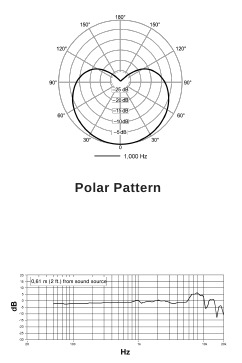
Accessories
Furnished Accessories
| MV5 Desktop Stand | AMV5-DS |
| 1 m USB cable | AMV-USB |
| 1 m Lightning cable | AMV-LTG |

Documents / Resources
References
Download manual
Here you can download full pdf version of manual, it may contain additional safety instructions, warranty information, FCC rules, etc.
Advertisement
Thank you! Your question has been received!




















Need Assistance?
Do you have a question about the MV5 that isn't answered in the manual? Leave your question here.